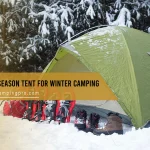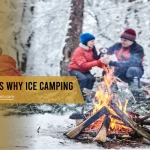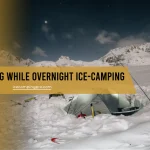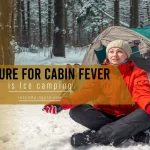Ice camping, also known as snow camping, is a type of camping that involves spending the night in a tent or other shelter on a layer of ice or snow. This type of camping presents unique challenges and requires special equipment and preparation.
Staying Warm While Ice Camping
One of the main challenges of ice camping is staying warm. In cold weather, the body loses heat quickly, and it is important to have adequate insulation to prevent hypothermia. Proper clothing is essential for staying warm while ice camping. Layering is key, as it allows for flexibility in regulating body temperature. Base layers should be made of materials that wick moisture away from the skin, such as synthetic fabrics or wool. Middle layers should provide insulation, such as fleece or down. And outer layers should be waterproof and windproof to protect against the elements.
Ice Camping is not for the Faint of Heart
Another challenge of ice camping is setting up camp. In snow and ice, it can be difficult to find a flat, stable surface for a tent. Snow shovels and snow saws can be used to level and cut blocks of snow for a tent platform. It is also important to stake down the tent securely to prevent it from blowing away in windy conditions.
Once the tent is set up, it is important to create a warm and comfortable sleeping environment. A sleeping pad or air mattress can provide insulation and cushioning, and a sleeping bag rated for cold weather is essential. It is also a good idea to bring extra blankets and warm clothing to use as layers while sleeping.
Food for Camping
In addition to warmth, proper nutrition is also important for a successful ice camping trip. In cold weather, the body burns more calories to stay warm, so it is important to bring high-energy, calorie-dense foods. Freeze-dried meals, nuts, and energy bars are good options. It is also important to stay hydrated, as dehydration can occur more quickly in cold weather. Water can be melted from snow, but it is important to purify it before drinking to prevent illness.
Read Also: Best Cool Box For Camping
Equipment for Camping
Ice camping also requires special equipment, such as snowshoes or skis for traveling over snow, and ice axes and crampons for climbing or traversing ice. It is important to have the proper equipment and know how to use it safely.
Overall, ice camping is a unique and challenging outdoor experience that requires careful preparation and the right equipment and skills. However, with the right mindset and precautions. It can be a rewarding and enjoyable way to connect with nature in the winter months.
How to Camp on the Ice
To camp on the ice, you will need to take several precautions to ensure your safety and comfort. Here are the basic steps you should follow:
- Choose a safe location: Look for a level area that is away from any potential hazards, such as cracks or thin ice.
- Prepare your gear: Bring a tent or other shelter that is designed for cold weather, as well as warm clothing, sleeping bags, and other supplies to keep you warm and comfortable.
- Set up camp: Clear any snow from the area where you will set up your shelter, and then set up your tent or other shelter according to the manufacturer’s instructions.
- Stay warm: During the day, stay active to keep your body warm. At night, use a heating pad or hot water bottle to warm your sleeping bag before getting in, and use a sleeping bag rated for cold weather.
- Monitor the ice: Keep an eye on the ice conditions, and be prepared to move to a safer location if necessary.
Remember to always take appropriate safety precautions when camping on the ice, and be sure to check the local regulations and guidelines before heading out. It is also a good idea to let someone know where you will be and when you plan to return, in case of emergency.
What are some essential item for ice camping?
When camping on the ice, it is important to have the right gear to keep you warm and safe. Some essential items for ice camping include:
- A tent or other shelter that is designed for cold weather
- Warm clothing, including a jacket, hat, gloves, and boots
- Sleeping bags rated for cold weather
- A heating pad or hot water bottle to warm your sleeping bag
- A camping stove and fuel for cooking
- Food and water
- A first aid kit and other emergency supplies
- Ice picks or other tools to help you get out of the water if you fall in
- A map and compass, or a GPS device
Remember to pack carefully and bring only the essential items that you will need. Over packing can make it more difficult to move around on the ice, and can also increase the risk of falling through the ice.
Best Places for Ice Camping
There are many places in the world where you can go ice camping, including the Arctic and Antarctica, as well as various locations in the northern and southern hemispheres. Some popular ice camping destinations include:
The Arctic
The Arctic is a vast and beautiful region that is home to a wide range of wildlife, including polar bears, seals, and arctic foxes. The ice and snow here provide a unique and challenging environment for camping, and many people enjoy the adventure of exploring this remote and rugged landscape.
Antarctica
Antarctica is the coldest and driest continent on Earth, and is known for its incredible scenery and wildlife. Camping on the ice here is an incredible experience, and many people enjoy the challenge of braving the harsh conditions to explore this remote and beautiful place.
Canada
Canada is home to many ice camping destinations, including the frozen lakes of the northern territories and the beautiful icefields of the Rocky Mountains. Many people enjoy the outdoor adventures that are possible in this vast and varied country.
Norway
Norway is known for its beautiful fjords and mountains, and many people enjoy ice camping in this stunning country. The frozen lakes and rivers here provide a unique and challenging environment for camping, and many people enjoy the adventure of exploring this beautiful landscape.
Overall, there are many places in the world where you can go ice camping, and the right destination for you will depend on your interests and the level of adventure you are looking for.
Pros of Ice Camping
Ice camping can be a unique and exciting way to experience the great outdoors. Some of the main benefits of ice camping include:
Adventure
Ice camping provides a unique and exciting adventure that is unlike any other form of camping. The challenge of braving the cold and the rugged terrain can be incredibly rewarding, and many people enjoy the sense of accomplishment that comes from successfully camping on the ice.
Scenery
Many ice camping destinations are located in beautiful and remote areas, and offer stunning views of the surrounding landscape. The pristine snow and ice of the Arctic, for example, can provide a breathtaking and unforgettable camping experience.
Wildlife
Many ice camping destinations are home to a wide range of wildlife, including polar bears, seals, and arctic foxes. These animals can provide a fascinating and exciting glimpse into the natural world, and many people enjoy the opportunity to see them up close.
Physical Activity
Ice camping can be a physically demanding activity, and many people find that it provides an excellent way to stay active and fit. The challenging terrain and cold weather can provide a great workout, and many people enjoy the feeling of being outside and active in the great outdoors.
Overall, ice camping can provide a unique and exciting adventure that is unlike any other form of camping. The challenging environment and stunning scenery can provide a rewarding and memorable experience, and many people enjoy the sense of accomplishment that comes from successfully camping on the ice.
Cons of Ice Camping
While ice camping can be a unique and exciting experience, it also comes with some potential challenges and drawbacks. Some of the main disadvantages of ice camping include:
Cold Weather
The main challenge of ice camping is the cold weather, which can be difficult to cope with and can even be dangerous if you are not prepared. Cold weather can cause hypothermia, frostbite, and other health problems, and it is important to take appropriate precautions to stay warm and safe.
Limited Supplies
Many ice camping destinations are located in remote and inaccessible areas, which can make it difficult to obtain supplies and equipment. This can be a particular problem if you need to replace or repair any of your gear, and it is important to plan carefully and bring everything you will need with you.
Difficult Terrain
The ice and snow of the Arctic and other ice camping destinations can provide a challenging and rugged terrain. This can make it difficult to move around and set up camp, and it can also increase the risk of falling through the ice or getting lost. It is important to be prepared for these challenges and to take appropriate safety precautions.
Limited Facilities
Many ice camping destinations do not have facilities such as bathrooms, showers, or electricity, which can make it difficult to maintain a comfortable and hygienic camping experience. It is important to be prepared for these challenges and to bring appropriate supplies and equipment with you.
Overall, ice camping can be a rewarding and exciting experience, but it is important to be aware of the potential challenges and to take appropriate precautions to stay safe and comfortable.
What do you need for ice camping?
To go ice camping, you will need the following gear and supplies:
- A tent or other shelter that is designed for cold weather.
- Warm clothing, including a jacket, hat, gloves, and boots.
- Sleeping bags rated for cold weather.
- A heating pad or hot water bottle to warm your sleeping bag.
- A camping stove and fuel for cooking.
- Food and water.
- A first aid kit and other emergency supplies.
- Ice picks or other tools to help you get out of the water if you fall in.
- A map and compass, or a GPS device.
Remember to pack carefully and bring only the essential items that you will need. Over packing can make it more difficult to move around on the ice, and can also increase the risk of falling through the ice. It is also important to choose the right gear and clothing to stay warm and safe in the cold weather.
Are ice shelters good for camping?
Yes, ice shelters are a good option for camping, especially in cold weather or snowy conditions. Ice shelters, also known as ice fishing shelters, are designed to provide protection from the cold and wind, and can help to keep you warm and comfortable while camping on the ice. Ice shelters are typically made from durable materials, such as nylon or polyester, and are designed to be lightweight and portable. They are usually easy to set up and take down, and can provide a comfortable and convenient place to sleep or rest while camping on the ice.
How do you make ice cubes for camping?
To make ice cubes for camping, you will need a few simple supplies, including:
- A cooler or other container that is large enough to hold the ice cubes
- Water
- Ice cube trays or other molding tools
To make the ice cubes, follow these steps:
- Fill the cooler or container with water, leaving enough space at the top to allow for expansion as the water freezes.
- Place the ice cube trays or other molding tools in the water, and make sure they are level and fully submerged.
- Place the cooler or container in a cold location, such as a garage or basement, and allow the water to freeze.
- Once the water is frozen, remove the ice cube trays or molding tools from the cooler, and gently twist or flex them to release the ice cubes.
- Store the ice cubes in the cooler or container, and use them as needed to keep your food and drinks cold while camping.
Remember to check the ice cubes regularly, and replace any that have melted or become contaminated. It is also a good idea to bring extra ice cubes with you, in case you need more than you originally planned for.
Can you sleep in an ice fishing tent?
Yes, you can sleep in an ice fishing tent. Designers create ice fishing tents, also known as ice shelters, to provide protection from the cold and wind and to serve as a comfortable and convenient place to sleep while camping on the ice. Manufacturers typically make ice fishing tents from durable materials, such as nylon or polyester, and design them to be lightweight and portable. They are usually easy to set up and take down, and provide enough space for one or more people to sleep comfortably.
How cold is too cold for ice fishing?
The temperature at which ice fishing becomes too cold will vary depending on the individual and their tolerance for cold weather. However, as a general rule, ice fishing in temperatures below freezing (32°F or 0°C) can be uncomfortable and potentially dangerous. In extreme cold weather, the risk of frostbite and other health problems increases, and it is important to take appropriate precautions to stay warm and safe.
What should you not do when ice fishing?
When ice fishing, there are several things you should avoid doing in order to stay safe and have a successful outing. Some things you should not do when ice fishing include:
Going out on the ice alone
It is always a good idea to go ice fishing with at least one other person, in case of emergency. This way, you can help each other if one of you falls through the ice or has other problems.
Going out on thin or unsafe ice
Before going out on the ice, it is important to check the ice conditions and make sure the ice is thick and safe. If the ice is thin or has cracks or other hazards, it is best to avoid fishing on it.
Not wearing the right clothing
It is important to wear warm, waterproof clothing when ice fishing, in order to stay warm and dry. This includes a jacket, hat, gloves, and boots, as well as several layers of clothing to help trap your body heat.
Not carrying the right equipment
It is important to carry the right equipment when ice fishing, including a life jacket, ice picks, a first aid kit, and a cell phone or other means of communication. This will help to keep you safe and prepared for any unexpected situations.
Read Also: Ice Camping and Backpacking Basics
Overall, it is important to be cautious and prepared when ice fishing, and to avoid taking unnecessary risks. By following these guidelines, you can help to ensure that your ice fishing trip is safe and successful.
How do ice fishing tents stay warm?
Designers create ice fishing tents, also known as ice shelters, to keep anglers warm by providing insulation and protection from the wind and cold. Manufacturers typically design ice fishing tents from durable materials, such as nylon or polyester, to trap heat and keep the interior warm. Designers typically include several layers of material in their designs, such as an inner layer of insulation, to keep heat in and cold out. In addition, many ice fishing tents have built-in heating systems, such as propane heaters, that can be used to warm the interior of the tent.
At what temperature is ice most slippery?
Ice is most slippery when the temperature is near freezing, around 32°F (0°C). Shoes or other objects moving across the ice slightly soften it and easily scratch or wear it away at this temperature. As the temperature drops below freezing, the ice becomes harder and more brittle, and is less likely to be slippery. However, even at lower temperatures, ice can still be slippery, especially if it is wet or covered with snow or other debris. It is always important to be cautious when walking on ice, and to take appropriate safety precautions to avoid slipping or falling.
Can I put fish directly on ice?
It is generally not a good idea to put fish directly on ice, as this can cause the fish to become frozen and can affect the quality of the meat. Instead, it is best to keep the fish in a separate container, such as a cooler or fish basket, and to place ice or ice packs around the container to keep the fish cold. This will help to keep the fish fresh and will prevent it from becoming frozen or damaged. It is also important to keep the fish out of direct contact with the ice, As this can cause the fish to become waterlogged and can affect the taste and texture of the meat.
Is it better to ice fish in the morning or at night?
Whether it is better to ice fish in the morning or at night will depend on a variety of factors, including the type of fish you are targeting and the conditions of the ice. In general, however, many ice fishermen prefer to fish in the morning, as the fish are often more active and easier to catch at this time of day. The early morning hours are also typically colder and more conducive to ice fishing, as the ice is firmer and more stable.
Conclusion
Ice camping is a unique and exciting way to experience the great outdoors. It involves camping on the ice. Typically in the Arctic or Antarctica, or in other cold and snowy regions of the world. Ice camping provides a challenging and exciting adventure, and offers the opportunity to see stunning scenery and wildlife. However, it also comes with some potential challenges and drawbacks, such as cold weather and difficult terrain. To ensure a successful and safe ice camping trip, prepare yourself and take appropriate safety precautions.










